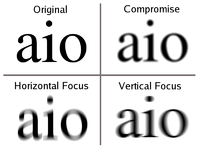
Photo from wikipedia
In this study we investigated the impact of accommodation on axial and oblique astigmatism along 12 meridians of the central 30° of visual field and explored the compensation of corneal… Click to show full abstract
In this study we investigated the impact of accommodation on axial and oblique astigmatism along 12 meridians of the central 30° of visual field and explored the compensation of corneal first-surface astigmatism by the remainder of the eye's optical system. Our experimental evidence revealed no systematic effect of accommodation on either axial or oblique astigmatism for two adult populations (myopic and emmetropic eyes). Although a few subjects exhibited systematic changes in axial astigmatism during accommodation, the dioptric value of these changes was much smaller than the amount of accommodation. For most subjects, axial and oblique astigmatism of the whole eye are both less than for the cornea alone, which indicates a compensatory role for internal optics at all accommodative states in both central and peripheral vision. A new method for determining the eye's optical axis based on visual field maps of oblique astigmatism revealed that, on average, the optical axis is 4.8° temporal and 0.39° superior to the foveal line-of-sight in object space, which agrees with previous results obtained by different methodologies and implies that foveal astigmatism includes a small amount of oblique astigmatism (0.06 D on average). Customized optical models of each eye revealed that oblique astigmatism of the corneal first surface is negligible along the pupillary axis for emmetropic and myopic eyes. Individual variation in the eye's optical axis is due in part to misalignment of the corneal and internal components that is consistent with tilting of the crystalline lens relative to the pupillary axis.
Journal Title: Journal of Vision
Year Published: 2017
Link to full text (if available)
Share on Social Media: Sign Up to like & get
recommendations!